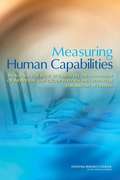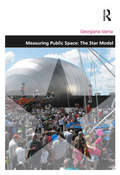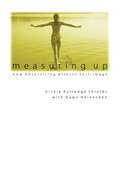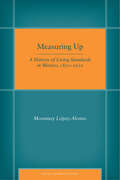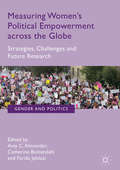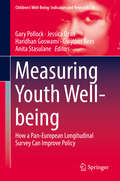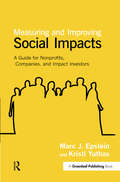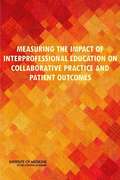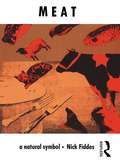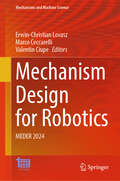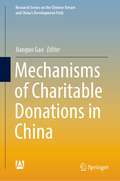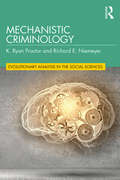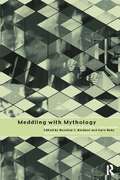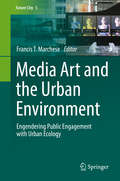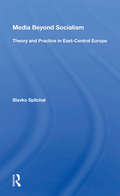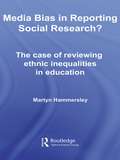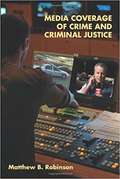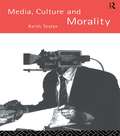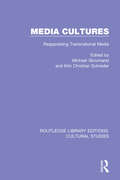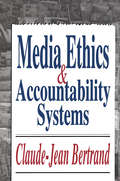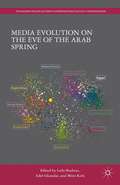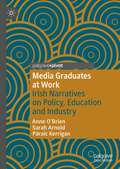- Table View
- List View
Measuring Human Capabilities: An Agenda for Basic Research on the Assessment of Individual and Group Performance Potential for Military Accession
by Committee on Measuring Human Capabilities: Performance Potential of Individuals CollectivesEvery year, the U. S. Army must select from an applicant pool in the hundreds of thousands to meet annual enlistment targets, currently numbering in the tens of thousands of new soldiers. A critical component of the selection process for enlisted service members is the formal assessments administered to applicants to determine their performance potential. Attrition for the U. S. military is hugely expensive. Every recruit that does not make it through basic training or beyond a first enlistment costs hundreds of thousands of dollars. Academic and other professional settings suffer similar losses when the wrong individuals are accepted into the wrong schools and programs or jobs and companies. Picking the right people from the start is becoming increasingly important in today's economy and in response to the growing numbers of applicants. Beyond cognitive tests of ability, what other attributes should selectors be considering to know whether an individual has the talent and the capability to perform as well as the mental and psychological drive to succeed? "Measuring Human Capabilities: An Agenda for Basic Research on the Assessment of Individual and Group Performance Potential for Military Accession" examines promising emerging theoretical, technological, and statistical advances that could provide scientifically valid new approaches and measurement capabilities to assess human capability. This report considers the basic research necessary to maximize the efficiency, accuracy, and effective use of human capability measures in the military's selection and initial occupational assignment process. The research recommendations of "Measuring Human Capabilities" will identify ways to supplement the Army's enlisted soldier accession system with additional predictors of individual and collective performance. Although the primary audience for this report is the U. S. military, this book will be of interest to researchers of psychometrics, personnel selection and testing, team dynamics, cognitive ability, and measurement methods and technologies. Professionals interested in of the foundational science behind academic testing, job selection, and human resources management will also find this report of interest.
Measuring Inequality: A Methodological Handbook
by Philip B. CoulterA social science handbook that comprehensively covers distribution in social science, inequality theory and the importance of distribution.
Measuring Public Space: The Star Model
by Georgiana VarnaIn the rapidly expanding public space debate of the past few years, a recurring theme is the ’loss of publicness’ of contemporary urban public places. This book takes up the challenge to find an objective way to prove or disprove this phenomenon. By taking the reader through a systematic and multi-disciplinary literature review it asks the deceptively simple question: ’What is publicness?’ It answers this by first developing a new theoretical approach - ’The dual nature of public space’, and secondly a new analytical tool for measuring it - ’The Star Model of Publicness’. This pragmatic approach to analysing public space is tested then on three new public places recently created on the post-industrial waterfront of the River Clyde, in the city of Glasgow, UK. By seeing where and why certain public places fail, direct and informed interventions can be made to improve them, and through this contribute to the building of more attractive and sustainable cities. By adopting a multi-disciplinary approach to shed light on this ’slippery’ concept, this book shows how urban design can complement other disciplines when tackling the complex task of understanding and improving the built environment’s public realm. It also bridges the gap between theory and practice as it draws from empirical research to suggest more quantitative approaches towards auditing and improving public places.
Measuring Up
by Dawn Heinecken Vickie Rutledge ShieldsThe mute gestures of advertising images are frozen for posterity by photographers and illustrators, gestures that, for better or worse, perpetuate a certain aesthetic and eventually become emblematic of a period. The images of today display the values of a society that has more interest in the body than the mind. They are technoenhanced labyrinths of unattainable appearances that leave women and men feeling horrified, estranged, and restricted by unrealistic, silent mandates. Measuring Up looks at advertising as more than just a way to extract money from unsuspecting people but as a vehicle for conveying the larger views of a confining, body-obsessed culture. By weaving theoretical and textual insights from feminist and cultural studies with the voices of real women and men, Measuring Up offers a unique reception analysis of the effects of repetitious exposure to advertisements of perfect bodies in our everyday lives. Shields examines a particular, complex relationship between the idealized images of gender we see in advertising and our own thoughts, feelings, and behavior in relation to these images. The study is unique in presenting audience reception in terms of ethnographic data, not textual interpretations alone. Measuring Up engages with and informs current theoretical debates within these sometimes complementary and sometimes contradictory literatures: feminist media studies, feminist film theory, critical social theory, cultural studies, and critical ethnography. This is an important work that explores the forms and channels of power used in one of the most insidious and overt means of mass influence in popular culture.
Measuring Up: A History of Living Standards in Mexico, 1850-1950
by Moramay Lopez-AlonsoMeasuring Uptraces the high levels of poverty and inequality that Mexico faced in the mid-twentieth century. Using newly developed multidisciplinary techniques, the book provides a perspective on living standards in Mexico prior to the first measurement of income distribution in 1957. By offering an account of material living conditions and their repercussions on biological standards of living between 1850 and 1950, it sheds new light on the life of the marginalized during this period. Measuring Upshows that new methodologies allow us to examine the history of individuals who were not integrated into the formal economy. Using anthropometric history techniques, the book assesses how a large portion of the population was affected by piecemeal policies and flaws in the process of economic modernization and growth. It contributes to our understanding of the origins of poverty and inequality, and conveys a much-needed, long-term perspective on the living conditions of the Mexican working classes.
Measuring What We Spend
by Don A. DillmanThe Consumer Expenditure (CE) surveys are the only source of information on the complete range of consumers' expenditures and incomes in the United States, as well as the characteristics of those consumers. The CE consists of two separate surveys: (1) a national sample of households interviewed five times at three-month intervals; and (2) a separate national sample of households that complete two consecutive one-week expenditure diaries. For more than 40 years, these surveys, the responsibility of the Bureau of Labor Statistics (BLS), have been the principal source of knowledge about changing patterns of consumer spending in the U. S. population. In February 2009, BLS initiated the Gemini Project, the aim of which is to redesign the CE surveys to improve data quality through a verifiable reduction in measurement error with a particular focus on underreporting. The Gemini Project initiated a series of information-gathering meetings, conference sessions, forums, and workshops to identify appropriate strategies for improving CE data quality. As part of this effort, BLS requested the National Research Council's Committee on National Statistics (CNSTAT) to convene an expert panel to build on the Gemini Project by conducting further investigations and proposing redesign options for the CE surveys. The charge to the Panel on Redesigning the BLS Consumer Expenditure Surveys includes reviewing the output of a Gemini-convened data user needs forum and methods workshop and convening its own household survey producers workshop to obtain further input. In addition, the panel was tasked to commission options from contractors for consideration in recommending possible redesigns. The panel was further asked by BLS to create potential redesigns that would put a greater emphasis on proactive data collection to improve the measurement of consumer expenditures. Measuring What We Spend summarizes the deliberations and activities of the panel, discusses the conclusions about the uses of the CE surveys and why a redesign is needed, as well as recommendations for the future.
Measuring Women’s Political Empowerment across the Globe
by Farida Jalalzai Amy C. Alexander Catherine BolzendahlThis volume brings together leading gender and politics scholars to assess how women's political empowerment can best be conceptualized and measured on a global scale. It argues that women's political empowerment is a fundamental process of transformation for benchmarking and understanding all political empowerment gains across the globe. Chapters improve our global understanding of women's political empowerment through cross-national comparisons, a synthesis of methodological approaches across varied levels of politics, and attention to the ways gender intersects with myriad factors in shaping women's political empowerment. This book is an indispensable resource for scholars of politics and gender, as well as being relevant to a global scholarly and policy community.
Measuring Youth Well-being: How A Pan-european Longitudinal Survey Can Improve Policy (Children's Well-being: Indicators and Research Ser. #19)
by Gwyther Rees Gary Pollock Jessica Ozan Haridhan Goswami Anita StasulaneThis volume presents key findings from the EU funded Measuring Youth Well-being (MYWeB) project which assessed the feasibility of a European Longitudinal Study for Children and Young People (ELSCYP). It draws on the original empirical data from a panel of experts in the field of child well-being as well as field experiences from a number of European countries. MYWeB explored strategies and methodological challenges for involving children and young people in well-being research in order to fight poverty and social exclusion. It does so by evaluating different options to measure the well-being of children and young people across Europe using a child centric approach.Written by experts researching children and young people from a variety of disciplinary backgrounds in the areas of sociology, psychology, political science, education, philosophy, economics, social policy, and evaluation.
Measuring and Improving Social Impacts: A Guide for Nonprofits, Companies and Impact Investors
by Marc J. Epstein Kristi YuthasIdentifying, measuring and improving social impact is a significant challenge for corporate and private foundations, charities, NGOs and corporations. How best to balance possible social and environmental benefits (and costs) against one another? How does one bring clarity to multiple possibilities and opportunities? Based on years of work and new field studies from around the globe, the authors have written a book for managers that is grounded in the best academic and managerial research.It is a practical guide that describes the steps needed for identifying, measuring and improving social impact. This approach is useful in maximizing the impact of different types of investments, including grants and donations, impact investments, and commercial investments.With numerous examples of actual organizational approaches, research into more than fifty organizations, and extensive practical guidance and best practices, Measuring and Improving Social Impacts fills a critical gap.
Measuring the Impact of Interprofessional Education on Collaborative Practice and Patient Outcomes
by Committee on Measuring the Impact of Interprofessional Education on Collaborative Practice Patient OutcomesInterprofessional teamwork and collaborative practice are emerging as key elements of efficient and productive work in promoting health and treating patients. The vision for these collaborations is one where different health and/or social professionals share a team identity and work closely together to solve problems and improve delivery of care. Although the value of interprofessional education (IPE) has been embraced around the world - particularly for its impact on learning - many in leadership positions have questioned how IPE affects patent, population, and health system outcomes. This question cannot be fully answered without well-designed studies, and these studies cannot be conducted without an understanding of the methods and measurements needed to conduct such an analysis. This Institute of Medicine report examines ways to measure the impacts of IPE on collaborative practice and health and system outcomes. According to this report, it is possible to link the learning process with downstream person or population directed outcomes through thoughtful, well-designed studies of the association between IPE and collaborative behavior. "Measuring the Impact of Interprofessional Education on Collaborative Practice and Patient Outcomes" describes the research needed to strengthen the evidence base for IPE outcomes. Additionally, this report presents a conceptual model for evaluating IPE that could be adapted to particular settings in which it is applied. "Measuring the Impact of Interprofessional Education on Collaborative Practice and Patient Outcomes" addresses the current lack of broadly applicable measures of collaborative behavior and makes recommendations for resource commitments from interprofessional stakeholders, funders, and policy makers to advance the study of IPE.
Measuring the Mosaic
by Rick Helmes-HayesMeasuring the Mosaic is a comprehensive intellectual biography of John Porter (1921-1979), author of The Vertical Mosaic (1965), preeminent Canadian sociologist of his time, and one of Canada's most celebrated scholars. In the first biography of this important figure, Rick Helmes-Hayes provides a detailed account of Porter's life and an in-depth assessment of his extensive writings on class, power, educational opportunity, social mobility, and democracy.While assessing Porter's place in the historical development of Canadian social science, Helmes-Hayes also examines the economic, social, political and scholarly circumstances - including the Depression, World War II, post-war reconstruction, the baby boom, and the growth of universities - that contoured Porter's political and academic views. Using extensive archival research, correspondence, and over fifty original interviews with family, colleagues, and friends, Measuring the Mosaic stresses Porter's remarkable contributions as a scholar, academic statesman, senior administrator at Carleton University, and engaged, practical public intellectual.
Meat: A Natural Symbol
by Nick FiddesThis book is a broad-ranging and provocative study of the human passion for meat. It will intrigue anyone who has ever wondered why meat is important to us; why we eat some animals but not others; why vegetarianism is increasing; why we aren't cannibals; and how meat is associated with environmental destruction.
Mechanism Design for Robotics: MEDER 2024 (Mechanisms and Machine Science #166)
by Erwin-Christian Lovasz Marco Ceccarelli Valentin CiupeThis book presents the proceedings of the 6th IFToMM Symposium on Mechanism Design for Robotics (MEDER), held in Timişoara, Romania, 27–29 June 2024. It gathers contributions by researchers from several countries on all major areas of robotic research, development and innovation, as well as new applications and current trends. The topics covered include: theoretical and computational kinematics, mechanism design, experimental mechanics, mechanics of robots, control issues of mechanical systems, machine intelligence, innovative mechanisms and applications, linkages and manipulators, micro-mechanisms, dynamics of machinery and multi-body systems. Given its scope, the book offers a source of information and inspiration for researchers seeking to improve their work and gather new ideas for future developments.
Mechanisms of Charitable Donations in China (Research Series on the Chinese Dream and China’s Development Path)
by Jianguo GaoThis book analyzes the positive changes, challenges, and corresponding solutions regarding charitable donation in China. It discusses a number of issues, including donors and their modes of donation, donation intermediaries and their behavioral characteristics, cultural and social factors influencing charitable donation, methods of raising charitable funds, ways of providing charitable assistance and innovation, and trends in the development of charitable donation mechanisms in China. Confirming previous findings and integrating theoretical and applied studies, the book draws new conclusions and offers fresh insights into the research questions. It also includes a multi-dimensional analysis of the behavioral patterns of the donors and the charitable donation mechanisms in contemporary China from integrated perspectives, with a systematic generalization of their key features and trends. Further topics explored include the community-based charity promotion mechanism and the trends in the mechanism development in China, which have seldom been touched on by other scholars in the field.
Mechanistic Criminology (Evolutionary Analysis in the Social Sciences)
by K. Ryan Proctor Richard E. NiemeyerThe science of criminology is at a crossroads. Despite accumulating a dizzying array of facts about crime, the field has yet to identify a body of theories that allows for the adequate prediction, explanation, and control of phenomena of central interest to criminologists. Mechanistic Criminology locates this problem within the field’s failure to conform to the expectations of scientific fields and reliance on antiquated methods of theory construction. The authors contend that this failure has resulted in an inability of criminologists to engage in theory falsification and competition—two central activities of science—that produce the forms of reliable knowledge that are unique to scientific fields. Mechanistic Criminology advocates for the adoption of a mechanistic mode of theorizing to allow criminologists to engage in theory falsification and competition and ignite rapid scientific discovery in the field. The proposed method is the same one employed within the biological sciences, which is responsible for their rapid scientific progress in the late twentieth and early twenty-first centuries. Should criminologists adopt this mechanistic approach, criminology could experience the same scientific revolution that is occurring in the biological sciences, and criminologists would generate the knowledge necessary for the prediction, explanation, and control of crime.
Meddling with Mythology: AIDS and the Social Construction of Knowledge
by Rosaline S. Barbour Guro HubyMeddling with Mythology examines the role of research in the construction of modern mythology or folklore surrounding HIV/AIDS. Researchers from a variety of disciplines reflect on the insights gained and the impact of their work, in light of the initial panic surrounding the prediction of an AIDS epidemic. Issues discussed include:- * power * representation * the politics of text * understanding research relationships * impact of research on researchers and responders * potential for change. Meddling with Mythology takes the reader from the theoretical to the practicable and from the public to the personal in the representations of AIDS. The issues raised here also have great significance for those concerned with the social construction of knowledge, theory building and the research process more generally.
Media Art and the Urban Environment
by Francis T. MarcheseThis text formally appraises the innovative ways new media artists engage urban ecology. Highlighting the role of artists as agents of technological change, the work reviews new modes of seeing, representing and connecting within the urban setting. The book describes how technology can be exploited in order to create artworks that transcend the technology's original purpose, thus expanding the language of environmental engagement whilst also demonstrating a clear understanding of the societal issues and values being addressed. Features: assesses how data from smart cities may be used to create artworks that can recast residents' understanding of urban space; examines transformations of urban space through the reimagining of urban information; discusses the engagement of urban residents with street art, including collaborative community art projects and public digital media installations; presents perspectives from a diverse range of practicing artists, architects, urban planners and critical theorists.
Media Beyond Socialism: Theory And Practice In East-Central Europe
by Slavko SplichalMedia Beyond Socialism treats the changing relationships among media, state, economy, and civil society in the current period of transition in East Europe from socialism to the establishment of Western-type democracies. Analyzing the relevance of mass communication and particularly of the media in the democratization process, the book addresses suc
Media Bias in Reporting Social Research?: The Case of Reviewing Ethnic Inequalities in Education (Routledge Advances in Sociology #Vol. 23)
by Martyn HammersleyIn recent years, the importance of disseminating the findings of social research has been given increased emphasis. The most effective way in which this can be done is via the mass media. However, there are frequent complaints that media coverage of social and educational research is very limited and often distorted. Through a detailed analysis of a particular case about ethnic inequalities in educational achievement, this book examines some of the processes involved in the reporting of research findings, and their implications for judgements about media distortion and bias. This volume is relevant to many fields, including education, media studies, cultural studies, sociology and social policy.
Media Coverage of Crime and Criminal Justice
by Matthew RobinsonMedia Coverage of Crime and Criminal Justice critically examines the media to identify how crime and criminal justice are treated in the news and entertainment media. The goal is not only to help shed light on important realities of crime and criminal justice in the United States but also to correct major misconceptions created by coverage of crime and criminal justice in the news, on television, in movies, in music, and other media forms. While there are other texts on the market focused on the impact of mass media on criminal justice, this text is the only one that starts with the issue of corporate ownership of the mass media as a potential problem for gaining an accurate understanding of the realities of crime and criminal justice. Further, this text presents basic information about the media in the introductory chapters and then applies this information to specific issues of crime and criminal justice in the rest of the book, thereby focusing on the same issues and themes throughout the book. Topics analyzed include how the media are organized, how they operate, and to what degree citizens are exposed to the media. Additionally, the book analyzes competing explanations of media coverage of crime and criminal justice, using examples from the real world to show why the media cover topics (and ignore others) the way they do. The book deals with media coverage of law-making and crime, policing, courts, and corrections. There are separate chapters of media coverage of each branch of criminal justice, with reviews of the literature focused on the most recent and influential research on these topics. The book also examines how the media both help and hinder effective crime control and crime prevention efforts. The book concludes with a summary of the book as well as suggestions for media reform, based on major findings of the book.
Media Culture & Morality
by Keith TesterFirst published in 1994. Routledge is an imprint of Taylor & Francis, an informa company.
Media Cultures: Reappraising Transnational Media (Routledge Library Editions: Cultural Studies)
by Michael Skovmand Kim Christian SchrøderThis book, first published in 1992, challenges the elitism and cultural pessimism of much Anglo-American and Continental cultural debate with regard to the role and power of transnational media practices. In a series of ten innovative essays, an international group of media researchers explores a wide range of cultural practices across national borders and the cultural politics associated with these everyday practices and debates.
Media Ethics and Accountability Systems
by Claude-Jean BertrandOver the last few years, the O.J. Simpson case, then the Lewinsky-Clinton affair, and scores of minor scandals have dominated the US press, often taking precedence over important domestic and international issues. This tabloidization of the news media, both here and abroad, has proved that "the market" cannot insure media quality. In a democracy, for media to function well, they must be free of both political and economic muzzling. The only solution is to add self-regulation, or quality control, by professionals and public to the other two forces, the market and state regulation.In this controversial volume, Claude-Jean Bertrand sets out to define a set of accountability systems--democratic, efficient, and harmless--to insure true freedom and quality of media. This brief, highly literate volume focuses not on philosophical foundations of media ethics or case stories, but on what is now missing in the codes. Many books deal with media ethics but few deal with accountability. Media Ethics and Accountability Systems zeroes in on the many nongovernmental methods of enforcing "quality control," and on the difficulty of getting the media microcosm to accept such accountability. To remedy this lack, Bertrand proposes rethinking existing "media accountability systems," some 30 to 40 in number, and creation of new ones. He observes that existing systems are rooted in four basic approaches: training: the education of citizens in media use and the incorporation of ethics courses in journalistic education; evaluation: criticism (positive and negative) not only from politicians, consumerists, and intellectuals, but from media professionals themselves; monitoring: by independent, academic experts over extended periods of time into the long-term effects; and feedback: giving ear to the various segments of media users and their needs and tastes, rather than scrutinizing sales and ratings.Media Ethics will be of particular interest to academics in the fields of communication and journalism, as well as to the general reader with an interest in public issues and a civic concern for society.
Media Evolution On The Eve Of The Arab Spring
by Mimi Kirk Adel Iskandar Leila HudsonMedia Evolution on the Eve of the Arab Spring brings together some of the most celebrated and respected names in Arab media research to reflect on the communication conditions that preceded and made the Arab uprisings possible.
Media Graduates at Work: Irish Narratives on Policy, Education and Industry (Creative Working Lives)
by Anne O'Brien Sarah Arnold Páraic KerriganThis book systematically examines various factors that shape graduates’ entry into media work, which include the state and its policies, industrial and organizational practices and cultures, and media education. However, the book does not take a typical political economic or even media industries approach to this exploration. Rather, it innovatively traces how these forces are operationalized to shape media work from the perspective of the graduates, their educators and their employers. These varying perspectives are analyzed to see how graduates experience the outcomes of policy, education and industry cultures. The book examines the impact that policy, education and industry have in redefining what media work means for parts of industry that are responsible for cultivating new entrants into the creative industries.
